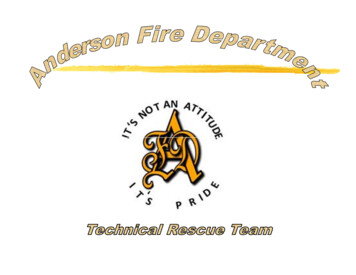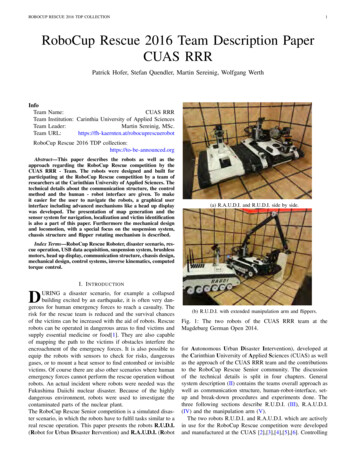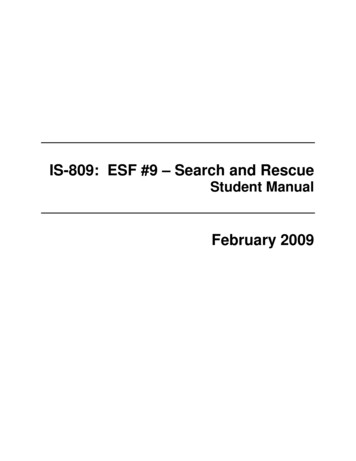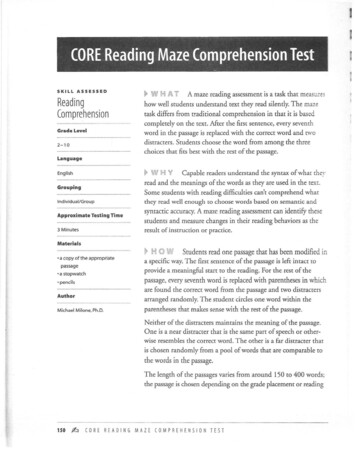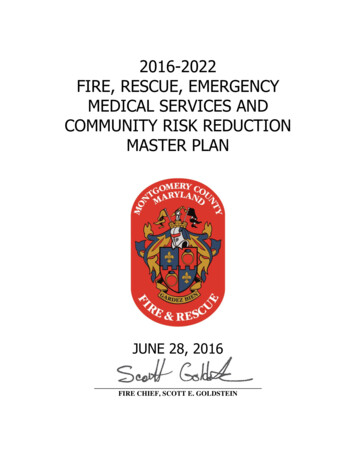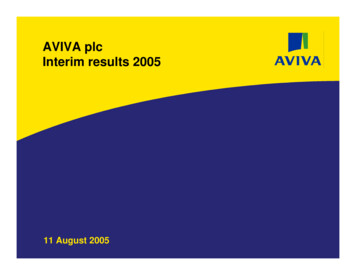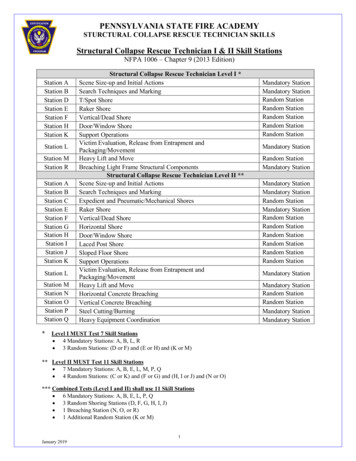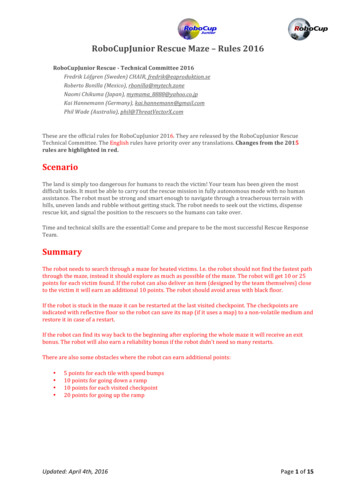
Transcription
RoboCupJunior Rescue Maze – Rules 2016RoboCupJunior Rescue - Technical Committee 2016Fredrik Löfgren (Sweden) CHAIR, fredrik@eaproduktion.seRoberto Bonilla (Mexico), rbonilla@mytech.zoneNaomi Chikuma (Japan), mymama 8888@yahoo.co.jpKai Hannemann (Germany), kai.hannemann@gmail.comPhil Wade (Australia), phil@ThreatVectorX.comThese are the official rules for RoboCupJunior 2016. They are released by the RoboCupJunior RescueTechnical Committee. The English rules have priority over any translations. Changes from the 2015rules are highlighted in red.ScenarioThe land is simply too dangerous for humans to reach the victim! Your team has been given the mostdifficult tasks. It must be able to carry out the rescue mission in fully autonomous mode with no humanassistance. The robot must be strong and smart enough to navigate through a treacherous terrain withhills, uneven lands and rubble without getting stuck. The robot needs to seek out the victims, dispenserescue kit, and signal the position to the rescuers so the humans can take over.Time and technical skills are the essential! Come and prepare to be the most successful Rescue ResponseTeam.SummaryThe robot needs to search through a maze for heated victims. I.e. the robot should not find the fastest paththrough the maze, instead it should explore as much as possible of the maze. The robot will get 10 or 25points for each victim found. If the robot can also deliver an item (designed by the team themselves) closeto the victim it will earn an additional 10 points. The robot should avoid areas with black floor.If the robot is stuck in the maze it can be restarted at the last visited checkpoint. The checkpoints areindicated with reflective floor so the robot can save its map (if it uses a map) to a non-volatile medium andrestore it in case of a restart.If the robot can find its way back to the beginning after exploring the whole maze it will receive an exitbonus. The robot will also earn a reliability bonus if the robot didn’t need so many restarts.There are also some obstacles where the robot can earn additional points: 5 points for each tile with speed bumps10 points for going down a ramp10 points for each visited checkpoint20 points for going up the rampUpdated: April 4th, 2016Page 1 of 15
ContentsRoboCupJunior Rescue Maze – Rules 2016 . 1Scenario . 1Summary . 11.Arena. 41.1 Description . 41.2 Floor . 41.3 Path . 41.4 Debris, Speed Bumps and Obstacles . 41.5 Victims . 51.6 Rescue Kits . 51.7 Environmental Conditions . 52.Robots . 62.1 Control . 62.2 Construction. 62.3 Team . 62.4 Inspection . 72.5 Violations . 73.Play . 83.1 Pre-round Practice . 83.2 Humans . 8Updated: April 4th, 2016Page 2 of 15
3.3 Start of Play . 83.4 Game play . 83.5 Scoring . 93.6 Lack of Progress . 103.7 End of Play . 104.Open Technical Evaluation . 114.1 Description . 114.2 Evaluation Aspects . 114.3 Awards . 114.4 Sharing . 125.Conflict Resolution . 125.1 Referee and Referee Assistant . 125.2 Rule Clarification . 125.3 Special Circumstances . 126.Code of Conduct . 136.1 Spirit . 136.2 Fair Play. 136.3 Behavior . 136.4 Mentors . 136.5 Ethics and Integrity . 136.6 Sharing . 14A.Suggested instructions to build LED Throwies (Rescue kits) . 15References . 15Updated: April 4th, 2016Page 3 of 15
1. Arena1.1 Description1.1.1 The maze may consist of multiple distinct areas. Areas will have a horizontal floor and a perimeter wall.1.1.2 Areas may be joined together by doorways or ramps.1.1.3 Walls that make up the maze are at least 15 cm high.1.1.4 Doorways are at least 30 cm wide.1.1.5 Ramps will be at least 30 cm wide and have an incline with a maximum of 25 degrees from horizontal surface.The ramp is always straight.1.2 Floor1.2.1 Floors may be either smooth or textured (like linoleum or carpet), and may have steps of up to 3 mm height atjoints. There may be holes in the floor (about 5 mm diameter), for fastening walls.1.2.2 Through the arena, there may exist black tiles that represent “no go” spaces. Black tiles will be placed randomlyat the start of each round. Black tiles may not be completely fixed on the floor.1.2.3 There may also exist silver tiles that represent checkpoints (see 3.6.2). Silver tiles may not be completely fixedon the floor.1.2.4 A tile is defined as a 30x30 cm space, which is aligned to the grid made up by the walls.1.3 Path1.3.1 Walls may or may not lead to the entrance/exit. Walls that lead to the entrance/exit are called linear walls. Thewalls that do NOT lead to the entrance/exit are called "Floating Walls".1.3.2 Paths will be approximately 30 cm wide with, but may open into foyers wider than the path.1.3.3 One of the outermost tiles is the starting tile, where a robot should start and exit the run.1.3.4 The starting tile is always a checkpoint.1.4 Debris, Speed Bumps and Obstacles1.4.1 Speed bumps are fixed to the floor, and have a maximum height of 2cm.1.4.2 Debris will not be fixed on the floor, and have a maximum height of 1cm.1.4.3 Debris may be spread towards or adjacent to walls.1.4.4 Obstacles may consist of any large, heavy items and its shape can be anything from rectangular, pyramidal,spherical to cylindrical.1.4.5 Obstacles have minimum height of 15 cm.1.4.6 Obstacle must not prevent a robot from discovering routes in the maze. An obstacle may be placed in anylocation where at least 20 cm is left between the obstacle and any walls.1.4.7 Obstacles that are moved or knocked over will remain where they are moved to/fall and will not be reset duringthe run.Updated: April 4th, 2016Page 4 of 15
1.5 Victims1.5.1 Victims are heated sources located near the floor of the arena (centered approximately 7 cm above the floor).1.5.2 Each victim has a surface area greater than 16 sq cm.1.5.3 The organizers will try to keep enough difference (minimum of 10 degrees Celsius) between victims'temperatures and the indoor temperature. The temperature of the victim simulates human body temperaturebetween 28oC to 40oC.1.5.4 There will be a minimum of five (5) active victims in any round.1.5.5 There may be objects that resemble victims in appearance, but are not heated. Such objects are not to beidentified as victims by robots.1.5.6 Victims will never be located on black tiles or on tiles with obstacles.1.6 Rescue Kits1.6.1 A Rescue Kit represents a basic health package distributed to a victim caught in a natural disaster. It symbolizestools or devices used in the rescue process, such as GPS Transponders or even something as simple as light sourceproviders.1.6.2 A Rescue Kit should preferably contain a lit-up LED, but could contain other electronics, weights or magnets.1.6.3 Each Rescue Kit must have a minimum volume of 1 cubic cm.1.6.4 Each team can only carry a maximum number of 12 of those kits.1.6.5 Some sample instructions for creating the rescue lit-up kit can be found the end of this document. Each team isencouraged to design their own versions.1.6.6 Each team is responsible for the whole Rescue Kits system (the maximum of 12 kits), including bringing therescue kits to the competition. Team captain is responsible for loading their own Rescue Kits on their robots andcleaning the field with the referee’s/judges’ authorization after the game is called to end.1.7 Environmental Conditions1.7.1 Teams should expect the environmental conditions at a tournament to be different from the conditions at theirhome practice field.1.7.2 Teams must come prepared to adjust their robots to the conditions at the venue.1.7.3 Lighting and magnetic conditions may vary along the course in the rescue arena.1.7.4 The arena may be affected by magnetic fields (e.g. generated by under floor wiring and metallic objects).1.7.5 Teams should prepare their robots to handle unexpected lightning interference. While the organizers andreferees will try their best to minimize external lighting interference, it is not possible for them to foresee allunexpected interferences such as camera flash from spectators.1.7.6 The Organizing Committee (OC) will try their best to fasten the walls onto the field floor so that the impact fromregular robot's contact should not affect the robot. (Refer to 6.1)1.7.7. All measurements in the rules have a tolerance of 5%.1.7.8. Objects to be detected by the robot will be distinguishable from the environment by their color or heatsignature.Updated: April 4th, 2016Page 5 of 15
2. Robots2.1 Control2.1.1 Robots must be controlled autonomously. The use of a remote control or manual control, or passinginformation (by sensors, cables, wirelessly, etc.) to the robot is not allowed.2.1.2 Robots must be started manually by the team captain.2.1.3 Robots may utilize various maze navigation algorithms. Pre-mapped type of dead reckoning (movementspredefined based on known locations before game play) is prohibited.2.1.4 A robot must not damage any part of the arena in any way.2.1.5 Robots should include a stop/pause button so they may be easily stopped/paused by humans to avert anypotentially damaging or illegal robot actions.2.2 Construction2.2.1 The height of a robot must not exceed 30 cm.2.2.2 Robots may not have any sensor or devices that enable it to 'see' over the walls.2.2.3 Any robot kit or building blocks, either available on the market or built from raw hardware and materials, maybe used, as long as the design and construction are primarily and substantially the original work of the students (seesection 2.5. below).2.2.4 Any commercially produced robot kits or sensors components that are specifically marketed to complete anysingle major task of RoboCupJunior Rescue will be disqualified. If there is any doubt, teams should consult theTechnical Committee (TC).2.2.5 For the safety of participants and spectators, only lasers of class 1 and 2 are allowed. This will be checkedduring inspection.2.2.6 Bluetooth Class 2, 3 and ZigBee communications are the only wireless types allowed in RoboCupJunior. Robotsthat have other types of wireless communications on board have to be either removed or disabled for possibleinterference with other leagues competing in RoboCup. If the robot has equipment for other forms of wirelesscommunication, the team must prove that they have disabled them. Robots that do not comply may face immediatedisqualification from the tournament.2.3 Team2.3.1 Each team must have only one robot in the field. (This rule can be modified in a Super Team Competition suchthat robots from different teams are are deployed together and have to cooperate in completing given tasks.)2.3.2 Each team must have a minimum of 2 members.2.3.3 Students will participate in ONLY ONE (1) of the three (3) divisions: Primary Rescue Line, Secondary Rescue Lineor Rescue Maze.2.3.4 Eligibility for the international event is: Rescue Line Primary: Open to students between 11 and 14 years old. Age is calculated as of July 1 for theinternational RCJ event each year. Rescue Line Secondary: Open to students from age of 11 up to and including 19 years of age. Teammembers may compete in Secondary Rescue twice at most (2 international events). After competing twicethey must move to Rescue Maze. Rescue Maze: Open to students from age of 11 up to and including 19 years of age.Updated: April 4th, 2016Page 6 of 15
2.3.5 The number of team members per team is limited to 6 members maximum but a team should choose theirteam size in a way that the learning experience of each member is maximized. Mentors/parents are not allowed tobe with the students during the competition. The students will have to self-govern themselves (without mentor'ssupervision) during the long stretch of hours at the competition.2.3.6 Every team member can be registered in only one team, and every team can compete in only oneRoboCupJunior league and division.2.4 Inspection2.4.1 The robots will be examined by a panel of referees before the start of the tournament and at other timesduring the competition to ensure that they meet the constraints described.2.4.2 It is highly unlikely that a team will be able to legally use a robot identical to another team’s robot fromprevious or the current year, or use a robot that is identical to another team’s robot.2.4.3 It is the responsibility of teams to have their robots re-inspected, if their robots are modified at any time duringthe tournament.2.4.4 Students will be asked to explain the operation of their robots, in order to verify that construction andprogramming of the robot is their own work.2.4.5 Students will be asked about their preparation efforts, and may be requested to answer surveys and participatein video-taped interviews for research purposes.2.4.6 All teams must fill a web form that will be provided once the team is officially registered, and should besubmitted at least one week prior to the competition. The purpose of this document is to allow judges to be betterprepared for the interviews. For sample documentation, please refer to the "Description of Materials Template" atthe official RCJ website under Rescue rules. Information about how to submit your document will be announced priorto the competition to the teams.2.4.7 All teams have to submit their source code prior to the competition. The source code is never shared with otherteams without the team’s permission.2.5 Violations2.5.1 Any violations of the inspection rules will prevent the offending robot from competing until modifications areapplied.2.5.2 However, modifications must be made within the time schedule of the tournament and teams must not delaytournament play while making modifications.2.5.3 If a robot fails to meet all specifications (even with modification), it will be disqualified from that round (but notfrom the tournament).2.5.4 No mentor assistance during the competition is allowed. See 6. Code of Conduct.Updated: April 4th, 2016Page 7 of 15
3. Play3.1 Pre-round Practice3.1.1 Where possible, competitors will have access to practice arenas for calibration, testing and tuning throughoutthe competition.3.1.2 Whenever there are dedicated independent arenas for competition and practice, it is at the organizers’discretion if testing is allowed on the competition arena.3.2 Humans3.2.1 Teams should designate one of its own team members as 'captain' and another one as 'co-captain'. Only thesetwo team members will be allowed access to the practice/competition arenas, unless otherwise directed by areferee. Only the captain will be allowed to interact with the robot during a scoring run.3.2.2 The captain can move the robot only when s/he is told to do so by the referee.3.2.3 Other team members (and any spectators) within the vicinity of the rescue arena have to stand at least 150 cmaway from the arena while their robot is active, unless otherwise directed by the referee.3.2.4 No one is allowed to touch the arenas intentionally during a scoring run.3.3 Start of Play3.3.1 A run begins at the scheduled starting time whether or not the team is present/ready. Start times will be postedprominently around the venue.3.3.2 Once the scoring run has begun, the playing robot is not permitted to leave the competition area for anyreason. Each run lasts a maximum of 8 minutes.3.3.3 Calibration is defined as the taking of sensor readings and modifying a robot’s program to accommodate suchsensor readings. Once the clock has started, a team may calibrate their robot at as many locations as desired on thearena, but the clock will continue to count down. A robot is not permitted to move using its own power whilecalibrating.3.3.4 Calibration time is not for pre-mapping the arena and/or victims location. Pre-mapping activities will result inimmediate robot disqualification for the round.3.3.5 Before a scoring run begins, a dice will be rolled to determine the location of the black and silver tiles. Theposition of the black tiles will NOT be revealed to the team until when they are ready to start a scoring run (see3.3.6). Referees will ensure the combination of black tile placements in a maze is 'solvable' before a robot begins ascoring run.3.3.6 Once the robot is started, a referee will place the black and silver tiles (determined by roll of dice as per 3.3.5).3.3.7 Once a scoring run has begun, no more calibration is permitted (this includes changing of code/code selection).3.4 Game play3.4.1 Modifying a robot during a run is prohibited; which includes remounting parts that has fallen off.3.4.2 All parts that the robot is losing intentionally or unintentionally will be left in the arena until the run is over.Neither the team nor the judge are allowed to remove parts from the arena during a run.3.4.3 Teams are not allowed to give a robot any advance information about the field. The robot is supposed torecognize the field by itself.3.4.4 A “visited tile” means that more than half of the robot is inside the tile when looking down from above.Updated: April 4th, 2016Page 8 of 15
3.5 Scoring3.5.1 Successful Victim Identification. Robots are rewarded points for each Successful Victim Identification in thearena:a) 10 points per "victim" located at a tile adjacent to a linear wall (even diagonally), i.e. all victims at the 6tiles around a linear wall.b) 25 points per "victim" at other walls.In the above diagram, red lines mean floating walls while the green ones represent linear walls.Note that some of the victims on the floating walls are worth 10p, this is because the 10p victims are located in a tilenear a linear wall. The colors on the diagram are just for illustrative purposes.To identify a victim, a robot must stop within 15 cm of the victim while flashing a lamp on and off for five seconds,and/or release a Rescue Kit before moving on. When a robot completes both, it counts as one victim identificationand one rescue kit deployment (see below).3.5.2 Successful rescue kit deployment. Robot should drop a rescue kit on the tile where the victim is, and thedeployment point needs to be within 15 cm proximity of the victim. The robot is awarded 10 points per successfulrescue kit deployment. There are no extra points for multiple kit deployments per victim.3.5.3 Reliability Bonus the number of ‘successful victim' identification" x 10 the number of ‘successful rescuedeployment’ x 10, minus the number of ‘Lack of Progress’ x 10. However, Reliability Bonus score can only be reduceddown to the minimum of 0 points.3.5.4 Successful Speed Bump Crossing. For each tile with speed bumps passed, a robot is awarded 5 points.3.5.5 Successful Up Ramp Negotiation. A robot is awarded 20 points for a successful climb of the ramp. Tosuccessfully climb up the ramp, a robot needs to move from the bottom horizontal tile before the ramp to the tophorizontal tile after the ramp.3.5.6 Successful Down Ramp Negotiation. A robot is awarded 10 points for successfully landing at the bottom of theramp. A robot needs to move from the top horizontal tile of the ramp to the bottom horizontal tile of the ramp. Asuccessful landing means that the robot can leave the tile without assistance.3.5.7 Successful Checkpoint Negotiation. A robot is awarded 10 points for each visited checkpoint. Refer to 3.4.4 fordefinition of visited tile.3.5.8 Successful Exit Bonus. A successful exit bonus is awarded when a robot successfully finishes a round on the starttile. It needs to stay there at least 10 seconds (this is to simulate the retrieval of a robot from the disaster zone). Thepoints awarded will be 10 points per victim successfully identified.3.5.9 Ties at the end. Ties in scoring will be resolved on the basis of the time each robot took to complete the run.3.5.10 No duplicate rewards. For example, if a robot successfully crosses a tile with speed bumps multiple times, onlyone Successful Speed Bump Crossing will be rewarded per tile. Same result applies to all other scoring rules.Updated: April 4th, 2016Page 9 of 15
3.6 Lack of Progress3.6.1 A Lack of Progress occurs whenA) The team captain declares a Lack of Progress.B) A robot fails to retreat from ‘visited’ black tile. For a successful retreat it needs to back up without turninginside the black tile (it has to move straight backwards inside of a black tile). See definition of visited tile on rule3.4.4.C) A robot or a team member damages the arena.D) A team member touches the arena or their robot without permission from a referee.3.6.2 If a Lack of Progress occurs, the robot must be returned to the last visited checkpoint. The robot can be placedin any direction. Refer to 3.4.4 for definition of visited tile.3.6.3 After a Lack of Progress, the team captain may reset the power supply (turn the robot off and on) and becauseof this the program is restarted. He is not allowed to change the program or give any information about the maze tothe robot.3.7 End of Play3.7.1 The team captain may declare an "end of round" if the team wants to stop the round early. The team will beawarded all points achieved up to the call for end of round.3.7.2 The round ends when:A) The time expires.B) The team captain calls end of round.C) The robot returns to the start tile and gets the exit bonus.Updated: April 4th, 2016Page 10 of 15
4. Open Technical Evaluation4.1 Description4.1.1 Your technical innovation will be evaluated during a dedicated time frame. All teams need to preparefor an open display during this time frame.4.1.2 Judges will go around interacting with teams. It will be set up as more like a casual conversation or"questions and answers" atmosphere.4.1.3 The main objective of the Open Technical Evaluation is to emphasize the ingenuity of innovation.Being innovative may mean technical advance as compared to the existing knowledge, or an out-of-theordinary simple but clever solution to existing tasks.4.2 Evaluation Aspects4.2.1 A standardized rubric system is used focusing on:a) creativityb) clevernessc) simplicityd) functionality4.2.2 "Your work" can include (but is not limited to) one of the following aspects:a) creation of your own sensor instead of a pre-built sensorb) creation of a "sensor module" which comprises of various electronics to provide a self-containedmodule to provide a certain special functionalityc) creation of a mechanic module which is functional, but out of the ordinaryd) creation of a new software algorithm to a solution4.2.3 Teams must provide documents that explain their work. Each invention must be supported byconcise but clear documentation. The documents must show concise inventive steps.4.2.4 Documents must include one poster and one engineering journal (see the Engineering JournalTemplate on official RCJ website for more details). Teams are expected to be readily prepared to explaintheir work.4.2.5 Engineering Journal should demonstrate your best practice in your development process.4.2.6 The poster should include name of team, country, league, robot description, robot capabilities,controller and programming language used, sensors included, method of construction, time used fordeveloping, cost of materials and awards won by the team in its country, etc.4.2.7 Guidelines may be provided at the official RCJ website under Rescue rules (Engineering JournalTemplate).4.3 Awards4.3.1 Awards may be divided into several categories.a) Innovation:- Mechanical innovation- Electronic innovation- Algorithm innovationb) Robust Design:- Mechanical design- Electronic design- Algorithm designc) Team work – demonstration of great collaborations within the team.d) Best Practice (in development) – demonstration of the best development practice fromUpdated: April 4th, 2016Page 11 of 15
brainstorming, designing, prototyping, development, test plan, quality assurance plan, etc.4.3.2 Awards will be given in the form of a certification.4.4 Sharing4.4.1 Teams are encouraged to review other's posters and presentations.4.4.2 The awarded teams are required to post their documents and presentation online if the TC asksthem.5. Conflict Resolution5.1 Referee and Referee Assistant5.1.1 All decisions during game play are made by the referee or the referee assistant who are in charge of the arena,persons and objects surrounding them.5.1.2 During game play, the decisions made by the referee and/or the referee assistant are final.5.1.3 At conclusion of game play, the referee will ask the captain to sign the score sheet. Captain should be givenmaximum 1 minute to review the score sheet and sign it. By signing it, the captain accepts the final score on behalf ofthe entire team; in case of further clarification, the team captain should write their comments in the score sheet andsign it.5.2 Rule Clarification5.2.1 If any rule clarification is needed, please contact the Internatio
RoboCupJunior Rescue Maze - Rules 2016 RoboCupJunior Rescue - Technical Committee 2016 Fredrik Löfgren (Sweden) CHAIR,fredrik@eaproduktion.se Roberto Bonilla (Mexico), rbonilla@mytech.zone Naomi Chikuma (Japan), mymama_8888@yahoo.co.jp Kai Hannemann (Germany), kai.hannemann@gmail.com Phil Wade (Australia), phil@ThreatVectorX.com These are .

